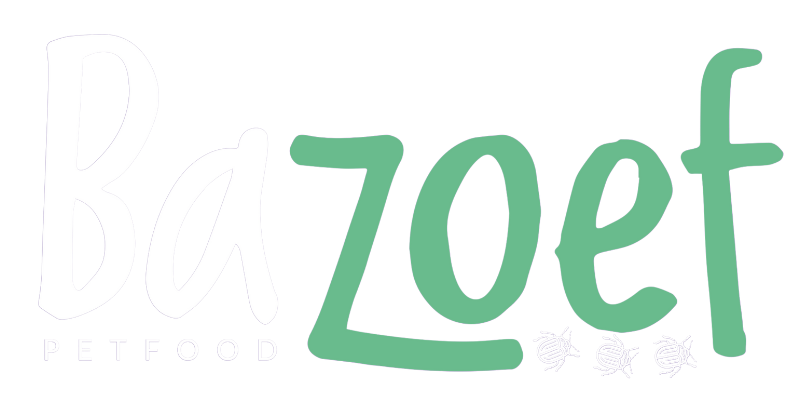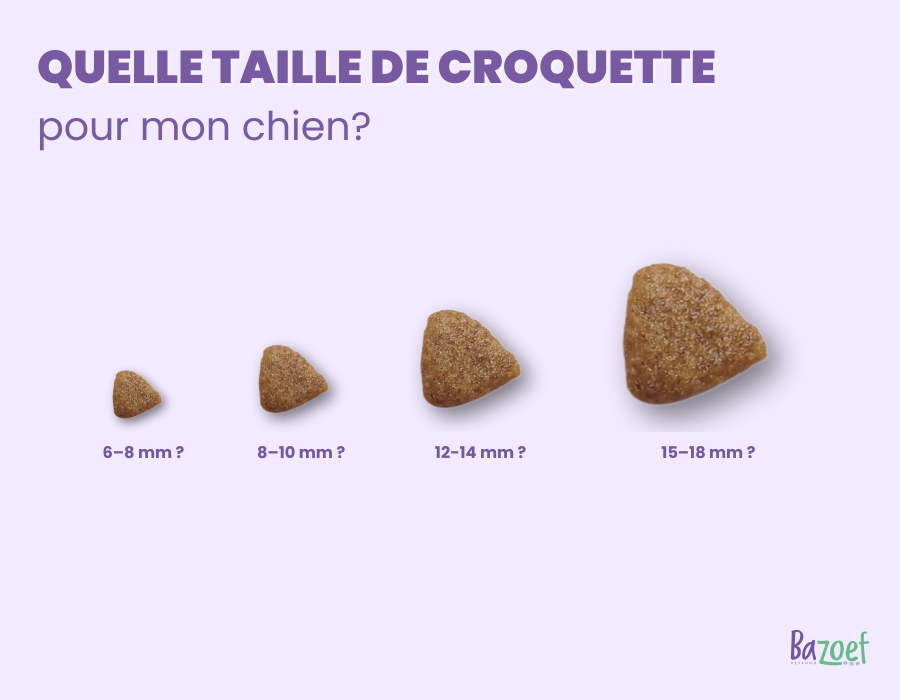When it comes time to choose the right food for your dog, most people focus on things like ingredients, protein content, or where the food comes from.
But there's one important factor that's often overlooked: the size of the kibble.
If the pieces are too small, your dog might swallow them whole without chewing, which can lead to digestive issues or weight gain.
If they’re too big, they can be hard to chew—and some dogs may even refuse to eat altogether. Jaw size, age, breed, and eating habits all play a role in making the right choice.
In this article, we’ll help you find the right kibble size to meet your dog’s specific needs—whether they’re a puppy, adult, or senior.

Recommended Kibble Size Based on Your Dog’s Size
Choosing the right kibble size isn’t just about your dog’s weight. Several factors come into play to ensure their food is healthy, safe, and tailored to their needs.
Here are the key things to consider:
- Size and weight: Larger dogs need bigger kibble that fits their jaw size, encouraging proper chewing.
- Jaw strength: Some small dogs have surprisingly powerful jaws, while older large dogs might struggle with sensitive teeth.
- Age: Puppy, adult, or senior—your dog’s chewing ability changes over time.
- Eating behavior: If your dog tends to gulp down food, larger kibble can help slow them down and improve digestion.
- Kibble design: Some brands offer uniquely shaped pieces (star-shaped, triangular, flattened) to better suit different jaw shapes and dental structures.

📊 Recommended Kibble Size by Dog’s Size and Age
| Dog Size & Weight | Puppy | Adult / Senior |
| Very Small (under 5 kg) | 6–8 mm | 6–8 mm |
| Small (5–10 kg) | 8–10 mm | 8–10 mm |
| Medium-Light (10–15 kg) | 8–10 mm | 10–12 mm |
| Medium (15–25 kg) | 10–12 mm | 12–14 mm |
| Large (25–40 kg) | 12–14 mm | 15–18 mm |
| Very Large (over 40 kg) | 14–16 mm | 18–22 mm |
Why Are There Different Kibble Sizes?
1. To Match Jaw Size and Strength
A Chihuahua and a German Shepherd don’t just differ in size—they have completely different jaw structures.
Kibble that’s too big for a small dog can be hard to chew or even pose a choking risk. On the other hand, kibble that’s too small for a large dog is often swallowed whole, with little or no chewing.
Example:
A 3 kg Yorkshire Terrier doesn’t have the same bite strength or teeth as a 30 kg Labrador. The Yorkshire needs 6–8 mm kibble, while the Labrador can comfortably chew 18 mm pieces.
2. To Encourage Chewing and Slow Down Eating
Larger kibble or specially shaped pieces (flat, triangular, star-shaped) encourage dogs to chew instead of gulping everything down.
This helps with digestion and reduces the risk of regurgitation or bloating—especially in fast eaters.
Example:
Large breeds like Boxers or Golden Retrievers, known for eating quickly, benefit from 18–22 mm kibble to slow their mealtime pace.
3. To Meet Age-Specific Needs
Puppies, adults, and seniors all have different dental and dietary needs.
Puppy kibble is usually smaller and softer, while senior formulas may be easier to digest or designed to be softened with water.
Example:
A 2-month-old Border Collie puppy will struggle with hard 15 mm kibble. On the flip side, a toothless senior dog may need smaller, softened kibble or a partially wet food blend.

Why Do Kibble Shapes Vary?
How Shape Affects Chewing
The shape of kibble can influence how your dog eats—encouraging chewing instead of swallowing whole.
This is especially important for dogs that eat too fast or for large breeds.
- Flat or oval kibble: Easier for short-muzzled dogs (like French Bulldogs) to pick up and chew.
- Ring-shaped or triangular kibble: Designed to promote more chewing, which slows down eating and supports better digestion.
Tailored to Your Dog’s Anatomy
Some kibble shapes are designed with specific dental and jaw structures in mind, based on a dog’s size or breed.
- Breed-specific kibble: For example, Labrador kibble tends to be larger to slow down their eating, while Yorkshire kibble is smaller and softer.
- Puppy or senior kibble: Often smaller, softer, or shaped for easier grip—ideal for dogs with less jaw strength or missing teeth.
📊 Kibble Shapes & Their Benefits
| Kibble Shape | Benefits (Chewing & Ingestion Speed) | Good for Fast Eaters? |
| Triangular | Edges slow chewing; abrasive effect helps reduce tartar | ✅ Yes |
| Star / Cross-shaped | Complex surface slows eating; improves dental cleaning | ✅ Yes |
| Round / Flat | Little resistance to fast eating; minimal tooth contact, not very abrasive | ❌ No |
| Pillow-shaped | Bulky and airy texture slows eating and encourages chewing | ✅ Yes |
| Concave / Crescent | Ergonomic shape slows eating; prolongs contact with teeth | ✅ Yes |
| Cylindrical / Stick | Easy to grasp and chew regularly; breaks cleanly but doesn't significantly slow down eating | ❌ No |
💡 Tip: For senior dogs or those with dental issues, you can soften any type of kibble by adding a bit of warm water or unsalted broth. This helps make it easier to chew while preserving the kibble’s nutritional value and texture.

What About Bazoef Kibble?

Bazoef Kibble: Two Key Features
- Triangular shape: Encourages chewing thanks to its angled edges, with a mild abrasive effect that helps reduce tartar buildup.
- 10 mm size: A medium-sized kibble, ideal for small to medium-light dogs.
📊 Bazoef Kibble — Evaluation Table
| Criteria | Assessment |
| Jaw size | Suitable for small dogs (5–10 kg) and medium-light dogs (10–15 kg) |
| Age | Designed for adult and senior dogs |
| Eating speed | Moderately effective for fast eaters |
| Oral health | A good choice for dogs prone to plaque buildup |
Conclusion
Choosing the right kibble size and shape for your dog’s build, age, and specific needs is essential for their overall health.
The right kibble does more than provide nutrition—it supports digestion, oral hygiene, and even shapes your dog’s eating behavior.
Puppies need small, easy-to-chew kibble. Adult dogs benefit from pieces suited to their jaw size and appetite. And seniors may require softer textures or moistened kibble to ease chewing and digestion.



